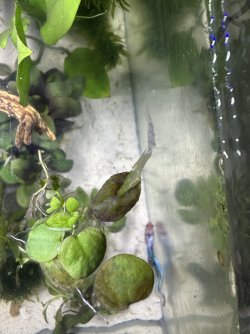The Big Figfetti
Fish Fanatic
Hello, I just joined the forums and posted an introduction, but I’m really hoping to get some help with my new tank.
It’s only 7 days old, but the plants don’t seem to be doing well. There’s a fuzz or haze around them and the driftwood.
I showed pictures to my LFS and they said it looked like biofilm and told me that the Oto would help clean it up. So far the oto hasn’t done anything but stay on the glass.
It’s a wasteland or low tech tank. No filter or skimmer. Just lights and a heater. I’m doing daily water changes. Between 25 and 50%. My ammonia just reached 0 yesterday for the first time. (Tested before the water change).
I just started using RO/DI water because I was having issues with hardness and pH. Levels all are in normal range now.
The tank is a 10gal, base of gravel, Fluval Bio Stratum, and sand on top of those. Some rocks and driftwood. I planted a bunch of things already. I went with the Aqueon Live planted clip on light.
No clean up crew yet.
Is the light the issue? Is it too strong, not strong enough? I was told that it would grow pretty much all the easy plants. But again, they have a film on them. The floaters, the Java fern, everything seems to have a haze.
Thanks for any advice!
It’s only 7 days old, but the plants don’t seem to be doing well. There’s a fuzz or haze around them and the driftwood.
I showed pictures to my LFS and they said it looked like biofilm and told me that the Oto would help clean it up. So far the oto hasn’t done anything but stay on the glass.
It’s a wasteland or low tech tank. No filter or skimmer. Just lights and a heater. I’m doing daily water changes. Between 25 and 50%. My ammonia just reached 0 yesterday for the first time. (Tested before the water change).
I just started using RO/DI water because I was having issues with hardness and pH. Levels all are in normal range now.
The tank is a 10gal, base of gravel, Fluval Bio Stratum, and sand on top of those. Some rocks and driftwood. I planted a bunch of things already. I went with the Aqueon Live planted clip on light.
No clean up crew yet.
Is the light the issue? Is it too strong, not strong enough? I was told that it would grow pretty much all the easy plants. But again, they have a film on them. The floaters, the Java fern, everything seems to have a haze.
Thanks for any advice!
Attachments
-
 8EC94B09-1883-4D11-A85D-D40B27719006.jpeg386.4 KB · Views: 47
8EC94B09-1883-4D11-A85D-D40B27719006.jpeg386.4 KB · Views: 47 -
 7F5F03A3-BECA-4CEB-98B4-2D90793521E6.jpeg356 KB · Views: 51
7F5F03A3-BECA-4CEB-98B4-2D90793521E6.jpeg356 KB · Views: 51 -
 87ACEBC3-62DE-4DE8-BEF3-8304BD11D411.jpeg381.8 KB · Views: 48
87ACEBC3-62DE-4DE8-BEF3-8304BD11D411.jpeg381.8 KB · Views: 48 -
 9D8A78BD-13A9-4447-9BE6-24F8724FC9BC.jpeg351.5 KB · Views: 41
9D8A78BD-13A9-4447-9BE6-24F8724FC9BC.jpeg351.5 KB · Views: 41 -
 E85B77A5-EFB3-4B36-9BE4-E17EB212490C.jpeg344.3 KB · Views: 41
E85B77A5-EFB3-4B36-9BE4-E17EB212490C.jpeg344.3 KB · Views: 41 -
 3C8E2AA2-AEB6-4970-9F51-6B23B0FA7B89.jpeg254.6 KB · Views: 51
3C8E2AA2-AEB6-4970-9F51-6B23B0FA7B89.jpeg254.6 KB · Views: 51 -
 BB944D3A-D30E-4822-886B-1FB70BC34432.jpeg239.5 KB · Views: 47
BB944D3A-D30E-4822-886B-1FB70BC34432.jpeg239.5 KB · Views: 47 -
 2EB05E13-1D3C-4475-9694-7A643A814030.jpeg209.7 KB · Views: 41
2EB05E13-1D3C-4475-9694-7A643A814030.jpeg209.7 KB · Views: 41 -
 23B51786-EF87-43DA-A8E4-A346596BE3FB.jpeg274.1 KB · Views: 39
23B51786-EF87-43DA-A8E4-A346596BE3FB.jpeg274.1 KB · Views: 39 -
 5ED34B16-E5B1-4EE0-87C6-6DEC08BA2E51.jpeg213.7 KB · Views: 39
5ED34B16-E5B1-4EE0-87C6-6DEC08BA2E51.jpeg213.7 KB · Views: 39 -
 CB4D0444-E791-40FA-AFF5-A345140BF04F.jpeg410.9 KB · Views: 53
CB4D0444-E791-40FA-AFF5-A345140BF04F.jpeg410.9 KB · Views: 53


